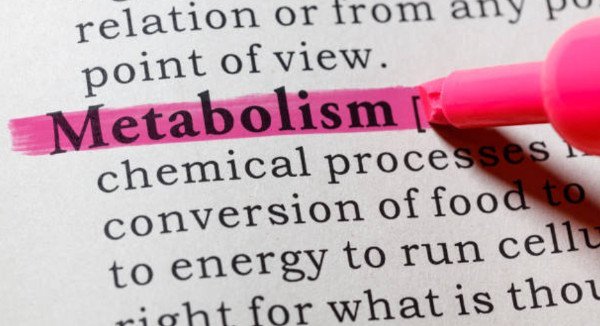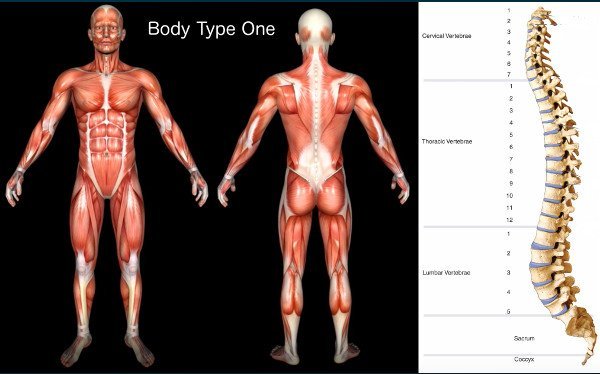
Metabolism, active and resting/passive, is the set of enzyme-catalyzed chemical reactions in living organisms that sustains life. Passive/resting metabolism is known as basal metabolic rate (BMR). It is calculated using the standard Mifflin St Jeor equation, which is the energy (calories) the average human body uses at rest to function daily. Active metabolism is the energy (calories) the human body uses for physical activity, be it cardio exercise, resistance/weightlifting training, or the like. It is reckoned using the Harris-Benedict equation.
Serving three main purposes, metabolism:
- converts food to energy/fuel to run cellular processes
- transforms that food/fuel into building blocks for proteins, lipids (fats), nucleic acids, and some carbohydrates
- eliminates metabolic wastes

Genetics/DNA, body type (including muscle/mass, skinny fat, and regular fat), diet, exercise, BMI, and lifestyle play key roles relative to a healthy metabolism which directly influences no less than aging and overall health. Metabolic reactions are typically categorized as catabolic (breaking down of compounds) or anabolic (building up of compounds). In general, catabolism releases energy while anabolism consumes energy.
How Muscle & Fat Affect and Influence Active & Passive/Resting Metabolism
The obesity epidemic remains a serious problem globally as healthcare systems struggle to truly understand and wrangle human health as a whole. With the dubious effectiveness of seemingly countless unscientific weight-loss diets and gimmicks as well as exercise programs and fads, scientifically discerning what does and does not actually work to lose, manage, and maintain weight is no easy task. Is there a scientific weight loss program that actually works for my specific body type? How is my body type scientifically defined? (Hint: The Four Body Types’ genetic Scientific Body Type Quiz)
Mainstream science defines things in terms of any Standard Scientific Human Body Anatomy Book Body Type One (BT1) image, like this:

The Standard Body Type One (BT1) is fully developed including vertebrae extension (posture) and muscle/muscle mass. How much muscle mass the specific individual human body has directly affects and influences metabolism, both active and passive/resting. The more properly developed muscle/muscle mass, the more calories the body burns at rest. A calorie is defined as the measure of energy in food consumed, specifically the measure of heat needed to raise a kilogram or a gram of water by one degree Celsius. As per mainstream science, when it comes to weight loss and looking identical to a standard BT1, the calorie is king.
Muscles Burn More Calories, Fat Burns Less Calories
 According to recent scientific estimates, on average ten (10) pounds of resting/passive (BMR) muscle burns sixty (60) calories per day, while ten (10) pounds of regular fat (white fat/yellow fat/excess fat) and/or skinny fat (thin fat, cellulite, crepey skin, loose skin, saggy skin, normal weight obesity) burns only twenty (20) to thirty (30) calories. At this time, it is 100% possible to get rid of regular fat through natural body processes. However, it is 0% possible to get rid of any type of skinny fat including cellulite through natural body processes; you can only reduce it through a few FDA-approved processes and manage it.
According to recent scientific estimates, on average ten (10) pounds of resting/passive (BMR) muscle burns sixty (60) calories per day, while ten (10) pounds of regular fat (white fat/yellow fat/excess fat) and/or skinny fat (thin fat, cellulite, crepey skin, loose skin, saggy skin, normal weight obesity) burns only twenty (20) to thirty (30) calories. At this time, it is 100% possible to get rid of regular fat through natural body processes. However, it is 0% possible to get rid of any type of skinny fat including cellulite through natural body processes; you can only reduce it through a few FDA-approved processes and manage it.
During the average day, brain function makes up roughly 20% of resting/passive (BMR) metabolism. The heart, which is beating all the time, accounts for another 15-20%. Next is the liver, which contributes another 15-20%. Then you have the kidneys and lungs and other tissues contributing 15-20%. Muscle, depending on how much your specific body has, contributes roughly 20-25% of total resting/passive metabolism. Finally, there is fat, the percentage of effect that fat weight has on resting/passive metabolism depends on how much regular fat and/or skinny fat is on your body.
Muscle Positively Affects Metabolism – Fat Negatively Affects Metabolism
When you exercise, you use muscle. This helps build muscle mass, and muscle tissue burns more calories — even when you’re at rest — than body fat. If it is, indeed true, that 10 pounds of resting/passive muscle burns sixty (60) calories per day and ten (10)  pounds of regular fat and/or skinny fat burns only twenty (20) to thirty (30) calories, then it is reasonable to conclude that how much regular fat or skinny fat is on the specific human body will negatively affect no less than passive/resting metabolism and eventually, at some threshold, slow metabolism down. Like in a genetic scientific Body Type Two (BT2), Body Type Three (BT3), or Body Type Four (BT4).
pounds of regular fat and/or skinny fat burns only twenty (20) to thirty (30) calories, then it is reasonable to conclude that how much regular fat or skinny fat is on the specific human body will negatively affect no less than passive/resting metabolism and eventually, at some threshold, slow metabolism down. Like in a genetic scientific Body Type Two (BT2), Body Type Three (BT3), or Body Type Four (BT4).
Whereas, the more fully developed muscle the body has, the more normal/average the metabolism will be (like in a Standard BT1). An average man has a rough Standard BMR of around 1697 calories (7,100 kJ) per day, while an average woman has a rough BMR of around 1410 calories (5,900 kJ) per day. Energy expenditure is continuous, but the rate fluctuates throughout the day.
BMR – Is a Fast Metabolism Possible?
That then leads to the logical conclusion that the more muscle/mass the body type has, the faster the metabolism. So, in theory, it is possible then to have a fast metabolism, if the body were to:
- have enough properly developed existing muscle on it, like with a Standard Scientific Human Body Anatomy Book Body Type One (BT1), and then
- have additional muscle(s)/mass added through, say, heavy weightlifting or the like, to significantly increase muscle mass above and beyond the normal/average Standard Body Type One (BT1).
As it stands now, no processes or set of variables have been openly identified to be able to test this theory. This is due to the fact that it would require knowing the exact amount of muscle/muscle mass on the specific human Body Type One (BT1) before heavy weightlifting began. On top of that, it would require being able to consistently track muscle mass added to the body over time. Although the technology (MRI) likely exists to do this, it is easier said than done.
Metabolic Threshold?
 However, would that not also mean that a person who is extremely/morbidly obese, like 600 pounds or more, even 1,000 pound sisters, that the fatter they are, the more fat they have, and thus the more calories they burn? Then, logically, would that not mean at some point, with so much fat, they would be burning so many calories that they should start losing weight due to all the fat?
However, would that not also mean that a person who is extremely/morbidly obese, like 600 pounds or more, even 1,000 pound sisters, that the fatter they are, the more fat they have, and thus the more calories they burn? Then, logically, would that not mean at some point, with so much fat, they would be burning so many calories that they should start losing weight due to all the fat?
But that is not the case.
No evidence exists currently that the fatter one gets, the more calories they burn, and thus at some point, they reach a metabolic threshold where they start losing weight because the fat starts to consume itself. Instead, all evidence at present strongly suggests that indeed a threshold is reached, but that threshold is the downward slide into more severe obesity and fat gain. So, how accurate is the whole “10 pounds of resting/passive muscle burns sixty (60) calories per day and ten (10) pounds of regular fat and/or skinny fat burns only twenty (20) to thirty (30) calories” claim?
Measuring Metabolism and Metabolic Rate
The Mifflin St Jeor equation — which calculates basal metabolic rate (BMR) — is considered to be the most accurate mathematically scientific measure for metabolism to date, for  both males and females.
both males and females.
- Female – ((9.99 x weight/kg)+(6.25 x height/cm)-(4.25 x age) – 166)x.15)-(9.99 x weight/kg)+(6.25 x height/cm)-(4.25 x age) – 166)
- Male – ((9.99 x weight/kg)+(6.25 x height/cm)-(4.25 x age) + 5)x.15)-(9.99 x weight/kg)+(6.25 x height/cm)-(4.25 * age) + 5)
Moreover, the Harris-Benedict equation is scientifically respected as a reliable means to estimate activity level. It produces a reliable overall metabolism/metabolic rate. Fellow One Research, using The Four (4) Body Type and Body Type Quiz scientific research data to date, has scientifically adjusted these equations to better evaluate things for each individual research participant’s body type. This is accomplished through the FORMR (Fellow One Research Metabolism Rate) Adjusted Mifflin St Jeor formula BMR score and FORMA (Fellow One Research Metabolism Activity) Adjusted Harris-Benedict formula activity score.
Slow, Normal, Fast Metabolism – Decreased, Steady, Increased Metabolic Rate
The FORMR formula determines the Mifflin-St Jeor equation BMR relative to proprietary The Four Body Types variables. It scores the individual research participant on a slow, normal/average, or fast (not possible at this time) metabolism scale. The FORMA formula reckons the Adjusted Harris-Benedict equation for activity (using basic cardio and resistance exercise along with work activity data). It judges the individual research participant in terms of a decreased, steady, or increased metabolic rate scale.
Take the Fellow One Research, The Four Body Types’ Scientific Body Type Quiz/Test to Learn Your Metabolism & Metabolic Rate Scores













